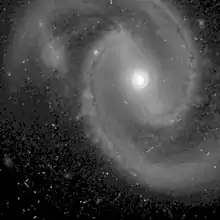NGC 1019
NGC 1019 is a barred spiral galaxy approximately 316 million light-years away from Earth in the constellation of Cetus.[2] It was discovered by French astronomer Édouard Stephan on December 1, 1880 with the 31" reflector at the Marseille Observatory.[4]
| NGC 1019 | |
|---|---|
 NGC 1019 (NASA/ESA HST) | |
| Observation data (J2000.0 epoch) | |
| Constellation | Cetus |
| Right ascension | 02h 38m 27.41s[1] |
| Declination | +01° 54′ 27.79″[1] |
| Redshift | 0.024340[1] |
| Helio radial velocity | 7297 ± 20 km/s[1] |
| Distance | 316 Mly[2] |
| Apparent magnitude (V) | 13.60[3] |
| Apparent magnitude (B) | 14.40[3] |
| Characteristics | |
| Type | SB(rs)bc[1] |
| Apparent size (V) | 1.0 × 0.9[1] |
| Other designations | |
| UGC 2132, MCG+0-7-68, PGC 10006 | |
NGC 1019 is classified as Type I Seyfert galaxy.[2] Its nuclei is surrounded by tight rings or annuli of star formation,[5] and the rings contain compact, young star clusters.[6]

NGC 1019 (SDSS)
References
- "NASA/IPAC Extragalactic Database". ned.ipac.caltech.edu. Retrieved 4 December 2017.
- Xanthopoulos, E. (1996). "VRI CCD surface photometry of Seyfert 1, Seyfert 2 and intermediate Seyfert-type galaxies". Monthly Notices of the Royal Astronomical Society. 280 (1): 6–28. Bibcode:1996MNRAS.280....6X. doi:10.1093/mnras/280.1.6.
- "Revised NGC Data for NGC 1019". spider.seds.org. Retrieved December 9, 2017.
- "Data for NGC 1019". www.astronomy-mall.com. Retrieved December 9, 2017.
- "Closeup views of Seyfert nuclei from HST". pages.astronomy.ua.edu. Retrieved 4 December 2017.
- "Star clusters in circumnuclear rings". ned.ipac.caltech.edu. Retrieved 4 December 2017.
External links
 Media related to NGC 1019 at Wikimedia Commons
Media related to NGC 1019 at Wikimedia Commons- NGC 1019 on WikiSky: DSS2, SDSS, GALEX, IRAS, Hydrogen α, X-Ray, Astrophoto, Sky Map, Articles and images
- SEDS
This article is issued from Wikipedia. The text is licensed under Creative Commons - Attribution - Sharealike. Additional terms may apply for the media files.